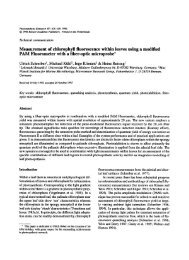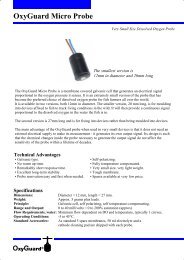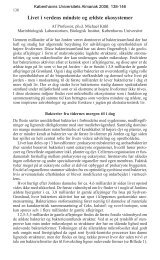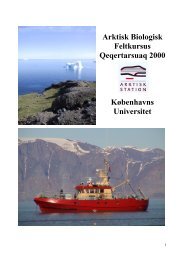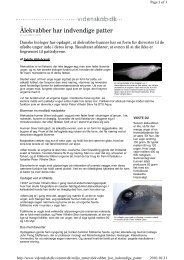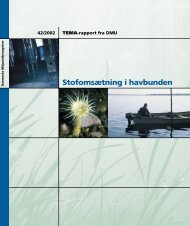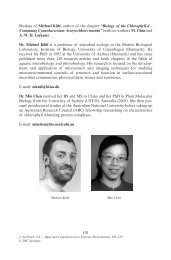Large Variabilities in Host Strain Susceptibility and Phage Host ...
Large Variabilities in Host Strain Susceptibility and Phage Host ...
Large Variabilities in Host Strain Susceptibility and Phage Host ...
Create successful ePaper yourself
Turn your PDF publications into a flip-book with our unique Google optimized e-Paper software.
VOL. 73, 2007 COMPLEXITY OF FLAVOBACTERIUM PHAGE-HOST INTERACTIONS 6731<br />
governed by these particular gene regions. The limitations<br />
associated with such species del<strong>in</strong>eation has recently been discussed<br />
<strong>in</strong> the context of stra<strong>in</strong>-specific niche occupation (21),<br />
where freshwater bacterial isolates with identical or almost-identical<br />
16S rRNA gene <strong>and</strong> ITS sequences were suggested to represent<br />
dist<strong>in</strong>ct populations <strong>and</strong> to probably occupy different ecological<br />
niches (17, 21). These limitations may also apply <strong>in</strong> the<br />
context of stra<strong>in</strong>-specific phage-<strong>in</strong>duced bacterial mortality.<br />
In the present study a collection of 21 Cellulophaga baltica<br />
(Bacteroidetes) stra<strong>in</strong>s, which were highly similar genotypically<br />
<strong>and</strong> phenotypically, allowed us to address phage-host <strong>in</strong>teractions<br />
at the stra<strong>in</strong> level. Our results demonstrate large stra<strong>in</strong>specific<br />
differences <strong>in</strong> phage susceptibility among hosts <strong>and</strong> a<br />
pronounced variability <strong>in</strong> specificity <strong>and</strong> efficiency of <strong>in</strong>fection<br />
for the C. baltica phages.<br />
MATERIALS AND METHODS<br />
Isolation of bacteria <strong>and</strong> phages. Stra<strong>in</strong>s NN014847 to NN016048 were isolated<br />
from various Danish coastal waters <strong>in</strong> 1994 (23). Stra<strong>in</strong>s MM#3 <strong>and</strong> #4 to<br />
#19 were isolated from Øresund surface water (56°2N, 12°37E) <strong>in</strong> February<br />
2000, <strong>and</strong> stra<strong>in</strong> OL12a was isolated from Baltic Sea surface water east off Öl<strong>and</strong><br />
(56°37N, 16°45E) <strong>in</strong> April 2005. The stra<strong>in</strong>s were selected as yellow colonies on<br />
CYT agar plates (1.0 g case<strong>in</strong>, 0.5 g yeast extract, 0.5 g CaCl 2 H 2 O, 0.5 g<br />
MgSO 4 H 2 O, 15 g agar, 1,000 ml deionized water, pH 7.3) with colony morphology<br />
(size, texture, <strong>and</strong> edge appearance) <strong>and</strong> restriction fragment length<br />
polymorphism (RFLP) profiles (16S rRNA gene, HaeIII, <strong>and</strong> NdeII; Roche)<br />
similar to those of the C. baltica type stra<strong>in</strong> (stra<strong>in</strong> NN015840) (23).<br />
<strong>Phage</strong>s were obta<strong>in</strong>ed from Øresund surface water <strong>in</strong> 2000 <strong>and</strong> 2005. After a<br />
0.45-m prefiltration (Millipak; Millipore), phages were concentrated 250-fold<br />
by tangential flow filtration (Millipore) followed by Amicon ultracentrifugation<br />
(Millipore). <strong>Phage</strong>s were isolated us<strong>in</strong>g the top-agar plat<strong>in</strong>g technique (plaque<br />
assay) (48), with all of the isolated bacterial stra<strong>in</strong>s used as hosts. Plaques with<br />
different morphologies were selected from each host <strong>and</strong> purified for three<br />
rounds of <strong>in</strong>fection <strong>and</strong> lysis. Thereafter, 5 ml phage buffer (0.1 M NaCl, 0.008<br />
M MgSO 4 , 0.05 M Tris-HCl, 2 mM CaCl 2 , 0.1% gelat<strong>in</strong>, 0.5 M tryptophan, 5%<br />
glycerol, pH 7.5) was added to a fully lysed plate, <strong>and</strong> the agar overlay was<br />
shredded with a sterile <strong>in</strong>oculation loop. The plate was <strong>in</strong>cubated on a shaker for<br />
20 m<strong>in</strong>, <strong>and</strong> the mixture was then transferred to a sterile tube <strong>and</strong> centrifuged<br />
(5,000 g, 10 m<strong>in</strong>). The supernatant was passed through a 0.22-m filter (Millex<br />
GS; Millipore), <strong>and</strong> the phage stock was stored at 4°C.<br />
In order to exam<strong>in</strong>e potential effects of resistance acquisition on host range,<br />
stra<strong>in</strong>s resistant to two of the isolated phages, S M <strong>and</strong> S T , were developed. These<br />
stra<strong>in</strong>s, #3 r S M <strong>and</strong> #3 r S T , were obta<strong>in</strong>ed after exposure of stra<strong>in</strong> MM#3 to<br />
the phages <strong>in</strong> laboratory experiments <strong>and</strong> isolated from fully lysed plates.<br />
Sequenc<strong>in</strong>g of the 16S rRNA gene <strong>and</strong> the ITS. Bacterial DNA was extracted<br />
us<strong>in</strong>g the DNeasy tissue kit (QIAGEN), <strong>and</strong> the 16S rRNA gene was PCR<br />
amplified us<strong>in</strong>g PuReTaq Ready-To-Go Beads (Amersham Biosciences) <strong>and</strong><br />
primers 27f <strong>and</strong> 1492r (15). The thermal program consisted of 30 cycles of 30 s<br />
of denaturation at 95°C, 30 s of anneal<strong>in</strong>g at 50°C, <strong>and</strong> 45 s of extension at 72°C,<br />
followed by 7 m<strong>in</strong> at 72°C. The ITS was amplified us<strong>in</strong>g primers G1 <strong>and</strong> 23Sr (21)<br />
<strong>and</strong> a thermal program consist<strong>in</strong>g of 35 cycles of 30 s of denaturation at 95°C, 30 s<br />
of anneal<strong>in</strong>g at 54°C, <strong>and</strong> 45 s of extension at 72°C, followed by 72°C for 7 m<strong>in</strong>.<br />
DNA was sequenced bidirectionally (commercially by Macrogen, Korea) us<strong>in</strong>g<br />
primers 27f, 530f, 519r, <strong>and</strong> 907r (26) for the 16S rRNA gene <strong>and</strong> primers G1 <strong>and</strong><br />
23Sr for the ITS. In some cases, the PCR-amplified ITS region could not be<br />
sequenced directly. The PCR products were therefore cloned prior to sequenc<strong>in</strong>g<br />
(TOPO TA clon<strong>in</strong>g kit; Invitrogen). Sequences were aligned <strong>in</strong><br />
Seqman (DNASTAR), <strong>and</strong> phylogenetic trees were constructed us<strong>in</strong>g the<br />
neighbor-jo<strong>in</strong><strong>in</strong>g algorithm <strong>in</strong> Clustal X (59).<br />
Genotyp<strong>in</strong>g by UP-PCR. Universally primed PCR (UP-PCR) is a whole-genome<br />
f<strong>in</strong>gerpr<strong>in</strong>t<strong>in</strong>g technique orig<strong>in</strong>ally developed for fungi (see reference 31<br />
for a review) <strong>and</strong> recently used to discrim<strong>in</strong>ate between genetically similar<br />
bacteria (7, 70). The UP-PCR method uses a s<strong>in</strong>gle primer to prime genomes<br />
arbitrarily, <strong>and</strong> the primer is designed to primarily target less-conserved <strong>in</strong>tergenic<br />
areas (31). Crude DNA templates for PCR (cell lysates) were prepared<br />
from each bacterial isolate as described by Br<strong>and</strong>t et al. (7) <strong>and</strong> stored at 20°C<br />
until use. UP-PCR was performed us<strong>in</strong>g the universal L15/AS19 primer 5-GAG<br />
GGT GGC GGC TAG-3 (32). PCR mixtures (20 l) consisted of molecular<br />
biology reagent-grade water (Sigma), buffer (supplied with DNA polymerase), 2<br />
mM MgCl 2 (supplied with DNA polymerase), 100 M of each deoxynucleoside<br />
triphosphate (AH Diagnostics), 1 ng l 1 of PCR primer (DNA Technology), 1<br />
unit of Dynazyme II DNA polymerase (F<strong>in</strong>nzymes, F<strong>in</strong>l<strong>and</strong>), <strong>and</strong> 1 l template<br />
DNA. PCR was carried out us<strong>in</strong>g the follow<strong>in</strong>g program: <strong>in</strong>itial denaturation at<br />
94°C for 3 m<strong>in</strong> <strong>and</strong> then 32 cycles consist<strong>in</strong>g of denaturation at 94°C for 60 s,<br />
primer anneal<strong>in</strong>g 53°C for 60 s, <strong>and</strong> elongation at 72°C for 60 s. In the first <strong>and</strong><br />
the last cycles, the elongation steps were extended to 90 s <strong>and</strong> 3 m<strong>in</strong>, respectively.<br />
PCR products were subjected to agarose gel electrophoresis (1.5%, 100 V, 40<br />
m<strong>in</strong>) <strong>and</strong> sta<strong>in</strong>ed with ethidium bromide. A 100-bp DNA ladder (Fermenta) was<br />
used as a molecular size marker. UP-PCR analysis was performed at least twice<br />
for each isolate to verify that reproducible b<strong>and</strong> patterns were obta<strong>in</strong>ed. Subsequently,<br />
the isolates were grouped based on identical UP-PCR patterns.<br />
Analysis of lipopolysaccharide (LPS) profiles. Bacterial stra<strong>in</strong>s were grown <strong>in</strong><br />
MLB medium (0.5 g Casam<strong>in</strong>o Acids, 0.5 g peptone, 0.5 g yeast extract, 3 ml<br />
glycerol, 500 ml filtered seawater [Øresund], <strong>and</strong> 500 ml dem<strong>in</strong>eralized water) at<br />
room temperature for 72 h. Pseudomonas fluorescens stra<strong>in</strong> Ag1, which was used<br />
as a reference, was grown to early stationary phase <strong>in</strong> LB medium (10 g tryptone,<br />
5 g yeast extract, 1 g glucose, 10 g NaCl, 1 liter Milli-Q) at 28°C.<br />
For preparation of prote<strong>in</strong>ase K-digested cell lysates, cells were centrifuged<br />
(10,000 g, 5 m<strong>in</strong>), washed once <strong>in</strong> phosphate-buffered sal<strong>in</strong>e, <strong>and</strong> resuspended<br />
<strong>in</strong> lysis buffer (0.5 M Tris-HCl [pH 6.8], 2% sodium dodecyl sulfate (SDS), 10%<br />
glycerol). Cell concentrations were normalized dur<strong>in</strong>g resuspension. Prote<strong>in</strong>ase<br />
K (75 g ml 1 ) was added <strong>and</strong> the lysates <strong>in</strong>cubated at 56°C for 1 h, boiled for<br />
5 m<strong>in</strong>, centrifuged (14,000 g, 30 m<strong>in</strong>), <strong>and</strong> stored at 20°C. Lysates were<br />
analyzed by SDS-polyacrylamide gel electrophoresis us<strong>in</strong>g 14% acrylamide–0.4%<br />
bisacrylamide <strong>and</strong> 4 M urea as described by Sørensen et al. (52), <strong>and</strong> a presta<strong>in</strong>ed<br />
prote<strong>in</strong> ladder (PageRuler Ladder Plus; Fermentas) was <strong>in</strong>cluded on each gel.<br />
After electrophoresis, gels were fixed <strong>in</strong> ethanol-acetic acid overnight <strong>and</strong> sta<strong>in</strong>ed<br />
with a periodic acid-silver sta<strong>in</strong> (60). Specificity of the sta<strong>in</strong><strong>in</strong>g was ensured by<br />
monitor<strong>in</strong>g silver sta<strong>in</strong><strong>in</strong>g of LPS from the <strong>in</strong>ternal control (P. fluorescens Ag1)<br />
without obta<strong>in</strong><strong>in</strong>g sta<strong>in</strong><strong>in</strong>g of the <strong>in</strong>cluded prote<strong>in</strong> ladder. The stra<strong>in</strong>s were<br />
grouped based on similar LPS profiles. The profiles were reproducible between<br />
<strong>in</strong>dependent replications, yet the <strong>in</strong>tensities of <strong>in</strong>dividual b<strong>and</strong>s, especially <strong>in</strong> the<br />
low-molecular-weight region, varied between runs.<br />
Specificity of phage <strong>in</strong>fection. To determ<strong>in</strong>e phage host range <strong>and</strong> the bacterial<br />
susceptibility to specific phages, a cross <strong>in</strong>fectivity test where all bacterial stra<strong>in</strong>s<br />
were exposed to all <strong>in</strong>dividual phage stocks was performed. Three microliters of<br />
phage stock (10 8 to 10 11 PFU ml 1 ) was spotted onto a lawn of host bacteria <strong>in</strong><br />
top agar, <strong>and</strong> plates were exam<strong>in</strong>ed for cell lysis after 1, 3, <strong>and</strong> 5 days. These spot<br />
tests were performed three <strong>in</strong>dependent times. Infection was considered positive<br />
when lysis (i.e., a clear<strong>in</strong>g zone) was seen <strong>in</strong> all three tests. In spot tests, spots may<br />
orig<strong>in</strong>ate from <strong>in</strong>hibition of bacterial growth, often seen as turbid spots, rather<br />
than direct viral lysis (39). To verify the presence of <strong>in</strong>fectious phages, plaque<br />
assays <strong>in</strong> dilution series were performed <strong>in</strong> some cases where turbid spots were<br />
seen. In all cases plaques were obta<strong>in</strong>ed, suggest<strong>in</strong>g that phage lysis caused the<br />
clear<strong>in</strong>g zones. An unweighted-pair group method us<strong>in</strong>g average l<strong>in</strong>kages<br />
(UPGMA) tree was constructed us<strong>in</strong>g the software Quantity One 4.2.1 (Bio-<br />
Rad), where the lysis/no lysis matrix was converted to pairwise distances us<strong>in</strong>g<br />
the Dice similarity coefficient.<br />
S<strong>in</strong>ce several bacterial stra<strong>in</strong>s were susceptible to the same phage, we sought<br />
to determ<strong>in</strong>e whether phage <strong>in</strong>fection was equally efficient <strong>in</strong> different hosts.<br />
Three hosts were exposed to the same phage titer, <strong>and</strong> <strong>in</strong>fectivity was quantified<br />
by plaque assay. PFU were exam<strong>in</strong>ed after 1, 2, <strong>and</strong> 3 days. This was performed<br />
for three different phages.<br />
<strong>Phage</strong> genome sizes. <strong>Phage</strong> genome sizes were determ<strong>in</strong>ed by pulsed-field gel<br />
electrophoresis (PFGE). Freshly made phage stocks (see above) were concentrated<br />
by ultracentrifugation (222,000 g, 2.5 h, 4°C; Beckman). DNA was<br />
obta<strong>in</strong>ed accord<strong>in</strong>g to the protocol for DNA (3) <strong>and</strong> quantified fluorometrically<br />
(PicoGreen; Molecular Probes). Some phage genomes dis<strong>in</strong>tegrated when<br />
extracted us<strong>in</strong>g this protocol. These were therefore lysed <strong>in</strong> agar plugs. Equal<br />
amounts of phage concentrate <strong>and</strong> melted 1.5% low-melt<strong>in</strong>g-po<strong>in</strong>t agarose<br />
(Sigma) <strong>in</strong> MSM buffer without gelat<strong>in</strong> (53) (450 mM NaCl, 50 mM MgSO 4 ,50<br />
mM Tris, pH 8.0) were mixed, transferred to plug molds, <strong>and</strong> left to solidify at<br />
4°C. The plugs were <strong>in</strong>cubated <strong>in</strong> lysis solution (0.25 M EDTA [pH 8], 1% SDS,<br />
1mgml 1 prote<strong>in</strong>ase K) overnight, washed three times <strong>in</strong> TE buffer (10 mM<br />
Tris-HCl, 1 mM EDTA, pH 8), <strong>and</strong> stored <strong>in</strong> TE at 4°C.<br />
For PFGE analysis, 20 ng DNA or 5 10 7 phage particles were loaded <strong>in</strong> each<br />
well. PFGE was performed on a CHEF-DR III system (Bio-Rad) us<strong>in</strong>g 1%<br />
PFGE certified agarose (Sigma). The gel was run for 11 h <strong>in</strong> 0.5 TBE buffer<br />
(1 TBE is 89 M Tris, 2 mM EDTA, <strong>and</strong> 89 mM boric acid, pH 8.3), at a 0.5-<br />
to 5.0-s switch time, 6 V/cm, <strong>and</strong> an <strong>in</strong>cluded angel of 120°. The gel was sta<strong>in</strong>ed<br />
with SYBR gold (Molecular Probes) for 30 m<strong>in</strong>, desta<strong>in</strong>ed <strong>in</strong> 0.5 TBE for 30<br />
m<strong>in</strong>, <strong>and</strong> photographed (Gel Doc XR; Bio-Rad). Genome sizes were determ<strong>in</strong>ed




